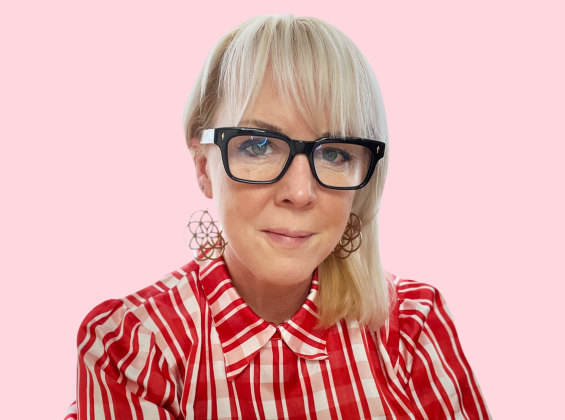What made you want to work in publishing?
I’ve got quite a literary background, my mother is a novelist, my father is a translator of Russian novels, and my great uncle was the poet Boris Pasternak. I was brought up with a lot of books, so in my head I always thought being a writer was an admirable profession. When I was four, I wrote an article for my school magazine, a piece about a velvet sausage dog at the school fair, and I remember seeing what I had written in print was overwhelming. I think honestly, from that moment on I knew this was what I wanted to do. My first published article was, weirdly, for Harper’s and Queen, they used to have a teenage issue.
You worked at Harper’s Bazaar early in your career and then went back in 2015, what drew you back to the title, and what did you notice had changed within the world of magazines?
I really loved working there, it was the late 90s and obviously it was amazing – total fashion fabulousness! I was Features Editor under the Editor at the time Fiona McPherson, who was a huge mentor to me. When she died, I left, because it drew a line under it for me. I moved to be deputy editor at The Sunday Times Style Magazine and then became a freelance writer and interviewer. Justine Picardie asked me to apply for the Deputy Editorship at Harper’s Bazaar in 2015. To be honest, nothing was further from my thoughts than going back into a full-time job. I was perfectly happy with two young-ish children and it was all working quite flexibly. But going back into the old offices on Broadwick Street where I had originally worked was just like this magnet that drew me back in. And I hugely admired Justine as a writer and an editor, so it was an offer I couldn’t refuse.
The difference going back to Harper’s Bazaar in 2015 was this whole digital aspect that wasn’t there before. I remember the frustration of knowing everything that was going on but not being able to react immediately. With digital and print, it felt as though you were able to get the best of both worlds. The other thing that had really changed was the number of events we did. The magazine had much more of a 360-degree approach, there was a focus on bringing it to life, and I really enjoyed that. We were, and still are, engaging with people across multiple platforms. When I started, I took over the Bazaar at Work series which became a monthly event and I enjoyed being able to meet readers regularly to get direct feedback on what they wanted to read about and be able to put that into practice.
You’ve been the Editor-in-Chief for just over a year, what’s the best thing about your job?
You’ve asked me a few days after the Bazaar Women of the Year event when I was sitting between Shiv Roy and Daphne Bridgerton… That’s quite a perk! But, more seriously, it’s the ability to celebrate the people, causes and cultural events that I feel really matter. It’s an enormous privilege. The other thing that’s wonderful is working with my team. They’re all at the top of their game and it’s a massive pleasure to work with these really talented people. I also love how different every day is. Harper’s Bazaar is a luxury fashion magazine, but it’s also a literary magazine with a big focus on art. It encompasses so many aspects of the best of culture.
What was it like editing a luxury women’s title in the depths of the pandemic?
Although I was appointed Editor-in-Chief last year, I was Acting Editor-in-Chief of Harper’s Bazaar for a year before that. It was challenging because there is a way of doing things on a luxury fashion title. Usually when we would try and set up a shoot, we would moodboard it, have a set designer, plan everything to the nth degree, and suddenly it was totally impossible to do that. While it wasn’t terribly enjoyable having to rethink everything we did, I do think going through it has made us all realise how much more flexible and adaptable we are.
A really great example was our Ashley Graham cover in the summer of 2020. We had been in talks with Ashley for months to secure her first cover after the birth of her baby. The shoot was planned to take place in a New York studio, and the look was going to be stripped back and sophisticated. But as COVID-19 hit the city, Ashley along with her newborn baby and husband drove back to their family home in Nebraska, while the photographer and stylist were in New York. But I remembered that her husband was a cinematographer and we asked him to shoot the pictures, and our creative director talked to him on Zoom. We managed to get some clothes out to her, Ashley’s mum did her makeup and it was as low key as you could possibly get. I actually thought it turned out really well – Ashley spoke to me about the road trip, her desire to escape and how it was all tied up with being a new mother. I wouldn’t have chosen to do it that way, but actually, I think it ended up being really intimate and beautiful, and really spoke to the times we were living through. And this has happened before with Harper’s Bazaar – for instance, during WWII, they couldn’t shoot covers, so they produced illustrated covers that have become iconic in their own right and are emblematic of a time.
Can you tell us about the Bazaar at Work Summit and why championing the career trajectories of women is so important to you?
When I arrived, Bazaar at Work was a quarterly magazine supplement focused on work wear. I launched a bespoke Bazaar at Work event, and we had a speaker come to talk about breaking through the glass ceiling. Afterwards, a lot of readers came up to me to say they had found it really interesting. Even though these were women at the very top of their game, they were still having difficulties at work, not being listened to, or being undermined or overlooked for promotion. They really wanted to talk about it and get advice. So, we started the Bazaar at Work Series . Every month we would feature someone in the magazine, who would also give a talk to our readers. They were really popular, and it made me realise I wanted Bazaar at Work to be a mix of things. It could be a really interesting interview with someone like Madeleine Albright or it could deal with topics like what you wear to work, or how to deal with toxic colleagues, or tips on speaking more authoritatively. The whole aim was to make you more comfortable and more successful at work. We thought, why don’t we put it all in one day, and that turned into the Bazaar At Work Summit.
I did want to still mix in the fashion, the glamour and high-octane gorgeousness of it all. The Bazaar strapline for many years was ‘Thinking Fashion.’ It’s always been aimed at intelligent, intellectual women who also like fashion, and it always seemed to me that splitting them up was wrong. And I liked the idea of creating a network of social, supportive women who will help each other along to greater success.
Last week it was the Women of the Year Awards, what were some of the new categories added?
We always will celebrate the great actress, musician, writer etc. but because we’ve all been through so much the past two years, it didn’t feel right to go back completely to business as usual. We had two slightly different awards this year and one was for Activist of the Year. We gave Soma Sara, the founder of Everyone’s Invited, the award. I find her inspiring because her approach to all the work she’s doing, and the way she encourages dialogue, is so positive. We also felt that there were people that, like Soma, had made a real difference to their local community, and they weren’t getting the recognition they deserved. I wanted to find a way to acknowledge that, so we created the Change Leader Award. We asked our readers to nominate a woman they felt had made a difference to her community. We had some really impressive women shortlisted. Our winner Caroline Herman set up a community project called All Yours, dedicated to raising money and awareness about period poverty in her local area. She was inspired by her 15-year-old daughter Cara and their conversations about those who would need help during the tough winter lockdown. What began as a small plea for donations soon engaged the entire local community. Herman’s initiative has now spread beyond her village, with a team of 27 volunteers running All Yours projects in communities across West Berkshire, South Oxfordshire, Reading, Basingstoke and Swindon. We gave Caroline the award with everyone else on the night, and Claire Foy referenced Caroline in her speech, saying she felt unworthy because she hadn’t changed the world in the same way.
Bazaar is about style, of course, but it’s also got substance and I feel that was a really good addition to a very glamorous evening.
Harper’s Bazaar is making commitments to sustainability, with an editorial focus in print and a dedicated section on your website. Was this born out of a want of this content from your readers or was this part of a wider content strategy to platform sustainable choices in fashion?
It’s both. We of course must be part of this conversation and our readers have an appetite for it. Our ethos has always been to buy less and buy better and I think if you’re starting from that point, it shouldn’t be so difficult to make sustainable choices. For example, we interviewed Livia Firth from Eco Age, and she was saying the key thing to ask yourself is, ‘Will I wear this 30 times?’ There isn’t a luxury brand out there that hasn’t got a focus on sustainability. Of course, there are also rental fashion companies, in which you can rent some wonderful things and secondhand purchases have really exploded, which is great. There are so many options out there and it’s our duty to bring them to our audience.
What’s on your radar?
The fact that events are coming back, I find this incredibly exciting. It’s wonderful to be out out! Meeting the readers in person is exhilarating. I was in Paris and Milan in September for their fashion weeks and it was absolutely fantastic to see the shows in real life again after they went digital during the pandemic. I suspect there will be an increasing fusion of digital and real life, it’s very exciting and I feel it has pushed everyone to a new level of creativity.
What magazine do you stockpile?
I have masses of Harpers and Queen from when I was there at the start of my career and obviously, Harper’s Bazaar! But I also have a whole box of vintage Marie Claire’s when it was a weekly French magazine. I found them at a French flea market. I have the very first issue from about 1921 and I have them going right through the war. So, when I’m feeling nostalgic they’re quite fun to flick through!
The December issue of Harper’s Bazaar is on sale now – https://www.harpersbazaar.com/uk/
Photo credit: Emma Hardy









